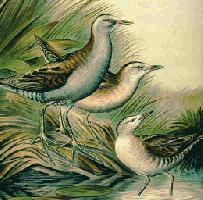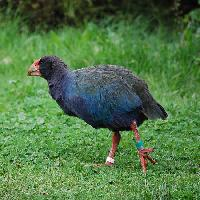
Descrierea animalului
The Little Crake (Zapornia parva) is a small, elusive waterbird that belongs to the Rallidae family, which is known for its array of species adapted to wetland habitats. This bird is particularly fascinating due to its diminutive size, secretive nature, and distinctive vocalizations. Its habitat primarily includes freshwater marshes, reed beds, and dense aquatic vegetation in temperate Europe and western Asia, extending into parts of Africa during the winter months.Adult Little Crakes are characterized by their striking plumage and compact body structure. They typically measure between 17 to 19 centimeters in length, making them one of the smallest species within their family. The male Little Crake showcases a rich, slate-grey face and upper parts, with a distinctive olive-brown hue on the back and wings. Its underparts are a lighter grey, contrasting sharply with the white undertail coverts. One of the most striking features of the male is its chestnut-colored flanks and breast sides, adorned with fine white barring that adds to its allure. The female, in comparison, is more subdued in coloration, displaying a brownish tone overall with less pronounced barring on the flanks. Both sexes have a short, yellow bill, red eyes, and greenish legs, which aid in their camouflage amidst the dense reed beds.
Juveniles resemble the female but are paler and have a more uniform coloration, lacking the distinctive barring and strong contrasts seen in adults. As they mature, the young birds gradually acquire the adult plumage.
Little Crakes are known for their secretive behavior, often remaining hidden within thick vegetation. They are more often heard than seen, with a vocal repertoire that includes a series of sharp, metallic calls and a distinctive, whirring trill that can carry over long distances in the quiet of the early morning and late evening.
Their diet is varied and includes a range of aquatic invertebrates such as insects, larvae, and small mollusks, as well as plant material. They forage by picking food items from the water's surface or by probing into the mud with their bills.
Breeding typically occurs from April to July. The Little Crake constructs a nest that is well concealed among dense aquatic vegetation, often attaching it to reeds or other plants above the water. The female lays a clutch of 6 to 12 eggs, which are incubated by both parents. The chicks are precocial, leaving the nest within a day of hatching, although they remain dependent on their parents for feeding and protection for several weeks.
Despite its wide range, the Little Crake faces threats from habitat destruction, particularly the drainage of wetlands for agriculture and urban development. While currently listed as Least Concern by the International Union for Conservation of Nature (IUCN), the conservation of suitable wetland habitats is crucial for the continued survival of this species and many others that rely on these ecosystems.
Animale similare
Fotografii noi cu animale
Top 10 animale
- Dolphin gull (Leucophaeus scoresbii)
- Diana monkey (Cercopithecus diana)
- Moustached guenon (Cercopithecus cephus)
- Greek tortoise (Testudo graeca)
- Stone loach (Barbatula barbatula)
- Galápagos tortoise (Geochelone nigra complex)
- Japanese macaque (Macaca fuscata)
- Russian tortoise (Testudo horsfieldii)
- Common flying dragon (Draco volans)
- Galápagos penguin (Spheniscus mendiculus)


